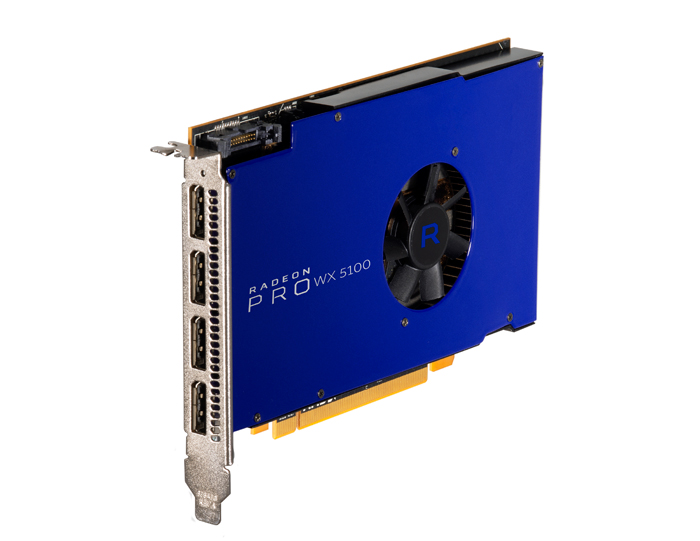Shackled by CPU frequency, AMD’s mid-range GPU is leaving CAD behind and looking for more demanding workflows on which to unleash its full power. By Greg Corke
Compared to CPUs, GPUs are advancing at an incredible pace. What was considered ‘high-end’ five years ago is now ‘entry-level’. This is great news for mainstream 3D CAD users, whose GPU requirements are relatively small compared to those of digital artists.
Today, a £250 professional GPU like the AMD Radeon Pro WX 4100 (4GB GDDR5 memory) should be able to handle pretty much anything a SolidWorks, Creo, Fusion or Revit user throws at it.
So where does this leave the traditional mid-range GPU? AMD’s ‘5X00’ series GPUs (FirePro W5000 and W5100) have long been nailed on for mainstream 3D CAD. But the latest addition, the AMD Radeon Pro WX 5100 (8GB GDDR5), is probably overkill for many 3D design workflows.
One of the reasons for this is that a lot of mainstream CAD software is CPU limited — meaning that the CPU is the bottleneck and does not allow the GPU to use its full resources. So, no matter how much GPU power you throw at a 3D CAD model, frame rates will not increase. In such cases, to boost 3D performance, you’d be better off investing in an extremely high-frequency CPU. It should be emphasised here that GHz is the key, as a CPU with more cores, over and above the standard four, will not do anything to increase frame rates.
This may go some way to explaining the scores we got with the AMD Radeon Pro WX 5100 in the SolidWorks 2015 SPECapc benchmark, where it was actually slower than its predecessor, the AMD FirePro W5100. The other probable explanation is driver maturity.
In CPU-limited workflows, application-specific driver optimisations can do a lot to help boost performance. As the Radeon Pro WX 5100 is so new (and based on a different architecture to the FirePro W5100), it is unlikely that it has yet been optimised for SolidWorks, although this should change with future driver releases.
To explore areas where the Radeon Pro WX 5100 would bring most benefit for designers, engineers and architects, we tested it with two applications that are gene r a l l y not CPU limited. Bentley Systems LumenRT and Autodesk LIVE are so-called ‘game engine’ design viz applications for architecture and construction projects. Here, the Radeon Pro WX 5100 took a commanding lead over the FirePro W5100 and also edged out the mid-range Nvidia Quadro M2000.
For many of our test models, we clocked frame rates in excess of 20 Frames Per Second (FPS), which is perfectly acceptable for most users. However, one complex animated LumenRT model peaked at 8.5 FPS so would likely benefit from a more powerful GPU, such as the Radeon Pro WX 7100 or Quadro P5000.
Modern GPUs aren’t just about accelerating 3D models, so we also tested the Radeon Pro WX 5100’s compute capabilities using AMD’s physically-based renderer, Radeon ProRender for SolidWorks. Impressively, it delivered our test render in just over half the time it took the FirePro W5100. It also had a small lead over the AMD FirePro W7100.
Conclusion
Based on our experiences with SolidWorks, there appears to be little incentive to invest in a Radeon Pro WX 5100 if you only need a GPU for mainstream 3D CAD (this may not be the case for more demanding 3D CAD applications such as Siemens NX).
Unless your CAD tool (and datasets) can break free from the shackles of CPU frequency, older-generation GPUs like the AMD FirePro W5100 or Nvidia Quadro M2000, or the new ‘entry-level’ AMD Radeon Pro WX4100, will likely deliver all the 3D performance you need.
This could change with future driver optimisations or a faster CPU (our test machine was only clocked at 3.5GHz, whereas the new ‘Kaby Lake’ Intel Core i7-7700K can comfortably go to 4.8GHz), but we expect the Radeon Pro WX 5100 will mainly benefit those who also have more demanding 3D design workflows.
Here, we’re talking about those built around ‘game engine’ or traditional design visualisation applications such as Autodesk 3ds Max, as well as GPU-based renderers like AMD Radeon ProRender (available for SolidWorks, Rhino, 3ds Max and others) or Chaos Group V-Ray RT. It is only in these workflows, where the GPU is not constrained by the frequency of the CPU, that the AMD Radeon Pro WX 5100 can showcase its true potential.
Supplier: AMD
Price: £354 + VAT
If you enjoyed this article, subscribe to AEC Magazine for FREE






